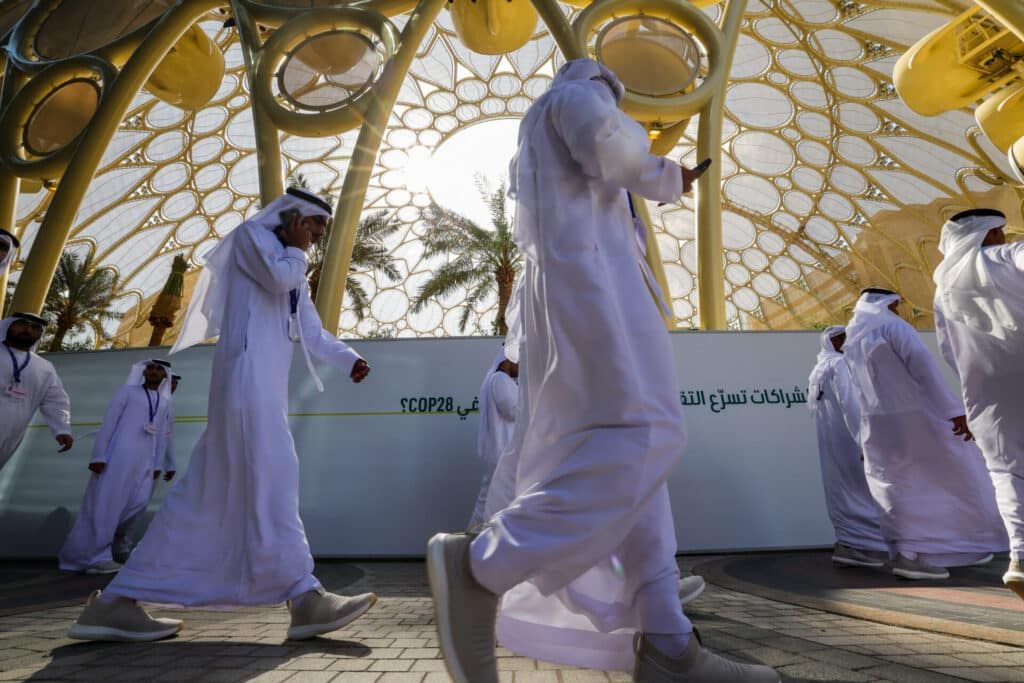COP28 and the nuclear energy numbers racket
By Sharon Squassoni | December 13, 2023
 Participants arrive at the venue of the COP28 United Nations climate summit in Dubai on November 29. (Photo by GIUSEPPE CACACE/AFP via Getty Images)
Participants arrive at the venue of the COP28 United Nations climate summit in Dubai on November 29. (Photo by GIUSEPPE CACACE/AFP via Getty Images)
Nuclear energy made a big splash at the COP28 climate meeting in Dubai with a declaration by 22 countries calling for a tripling of nuclear energy by 2050. It seems like an impressive and urgent call to arms. On closer inspection, however, the numbers don’t work out. Even at best, a shift to invest more heavily in nuclear energy over the next two decades could actually worsen the climate crisis, as cheaper, quicker alternatives are ignored for more expensive, slow-to-deploy nuclear options.
Here’s what the numbers say:
22: That 22 countries signed the declaration may seem like a lot of support, but 31 countries (plus Taiwan) currently produce nuclear energy. Notably missing from the declaration are Russia and the People’s Republic of China. Russia is the world’s leading exporter of nuclear power plants and has the fourth largest nuclear energy capacity globally; China has built the most nuclear power plants of any country in the last two decades and ranks third globally in capacity. Thirteen other countries that have key nuclear programs are also missing from the declaration: five in Europe (Armenia, Belarus, Belgium, Switzerland and Spain), two in South Asia (India and Pakistan) three in the Americas (Argentina, Brazil and Mexico), South Africa (the only nuclear energy producer in Africa), and Iran.
5: Five of the countries signing the declaration do not have nuclear power—Mongolia, Morocco, Ghana, Moldova, and Poland. Only Poland’s electricity grid can support three or four large nuclear reactors—the rest would have to invest billions of dollars first to expand their grids or rely on smaller reactors that would not overwhelm grid capacity. Poland wants to replace its smaller coal plants with almost 80 small modular reactors (SMRs), but these “paper reactors” are largely just plans and not yet proven technology. One American vendor, NuScale, recently scrapped a six-unit project when cost estimates rose exponentially. In any event, none of these five countries is likely to make a significant contribution toward tripling nuclear energy in the next 20 years.
17: The 17 remaining signatories to the nuclear energy declaration represent a little more than half of all countries with nuclear energy, raising the issue of how much support there really is for tripling nuclear energy by 2050.
3x: The idea of tripling nuclear energy to meet climate change requirements is not new. In fact, it was one of eight climate stabilization “wedges” laid out in Science magazine in 2004 in a now-famous article by Robert Socolow and Stephen Pacala of Princeton University. A stabilization wedge would avoid one billion tons of carbon emissions per year by 2055. In the case of nuclear energy, this would require building 700 large nuclear reactors over the course of 50 years. (In 2022, there were 416 reactors operating around the world, with 374 gigawatts-electric of capacity). In 2005, to reach the one-billion-ton goal of emissions reduction would have meant building 14 reactors per year, assuming all existing reactors continued operating. (In fact, the build rate needed to be 23 per year to replace aging reactors that would need to be retired.) Given the stagnation of the nuclear power industry since then, the build rate now to reach wedge level would need to be 40 per year.
10: Average annual number of connections of nuclear power plants to the electricity grid, per year, over the entire history of nuclear energy. Between 2011 and 2021, however, the average annual number of nuclear power reactors connected to the grid was 5.
42 GWe: New nuclear energy capacity added from 2000 to 2020.
605 GWe: New wind capacity added from 2000 to 2020.
578 GWe: New solar capacity added from 2000 to 2020. Growth in renewables has vastly outpaced that of nuclear energy in recent years.
73 billion: In US dollars, the amount lent or granted by the World Bank in fiscal year 2023 through the International Bank of Reconstruction and Development and the International Development Association for projects. The December nuclear energy declaration called upon shareholders of the World Bank, international financial institutions, and regional development banks to encourage the inclusion of nuclear energy in their lending policies. This sounds like it would improve the chances for nuclear energy investment, but like many things associated with nuclear energy, any such move would be far too little and too late. The recently cancelled NuScale project estimated that it would cost $9.3 billion for six small modular reactors (77 megawatts-electric each); that is, the six reactors would have half the electricity capacity of a single large reactor. If the World Bank decided to spend all its funds on nuclear energy, it could afford to pay for the construction of seven NuScale projects, which would increase nuclear energy capacity by three gigawatts-electric—or one percent of total global capacity. The opportunity costs of using scarce development funds on nuclear energy is another issue.
15 trillion: In US dollars, the cost to build enough NuScale reactors (9,738 77 megawatt-electric reactors) to triple nuclear energy capacity, assuming existing reactors continue to operate. There are less expensive SMRs, perhaps, but none further along in the US licensing process.
13: An unlucky number in some cultures, but this was the time from design to projected operation of the NuScale VOYGR plant. Nuclear power plants have to be “done right,” and cutting corners to speed deployment is in no one’s interests. The design-and-build phase for a country’s first nuclear reactor, according to the International Atomic Energy Agency, is 15 years. If the great expansion of nuclear energy is supposed to occur in more than the 22 countries that signed the declaration, this lead-time cannot be ignored.
The climate crisis is real, but nuclear energy will continue to be the most expensive and slowest option to reach net zero emissions, no matter how you cook the numbers.
Together, we make the world safer.
The Bulletin elevates expert voices above the noise. But as an independent nonprofit organization, our operations depend on the support of readers like you. Help us continue to deliver quality journalism that holds leaders accountable. Your support of our work at any level is important. In return, we promise our coverage will be understandable, influential, vigilant, solution-oriented, and fair-minded. Together we can make a difference.
Keywords: Dubai, NuScale, SMRs, cop28, nuclear energy
Topics: Climate Change, Nuclear Energy
















Even at best, a shift to invest more heavily in nuclear energy over the next two decades could actually worsen the climate crisis, as cheaper, quicker alternatives are ignored for more expensive, slow-to-deploy nuclear options. At best it “could”, eh? And at less-than-best, it could greatly alleviate the climate crisis, just as it has done in recent decades, if — as appears to be the case — “best”, in Squassoni’s lexicon, means “most effective at protecting governments’ fossil fuel tax revenues”. By that measure, nuclear power has always done more harm than good. If the options that in recent years… Read more »
This is article is written by somebody who hates nuclear energy and its people like that who have removed a once feasible solution to the climate crisis into a relic of the past. No expertise is present in the developing world to build the new reactor designs at reasonable cost, because the builders and engineers who could do it for cheap leveraging experience are now long gone. renewables don’t provide reactive vars to deal with industrial loads. Neither are they predictable and require very large batteries to provide constant generation. They can not be standalone. China successfully built multiple new… Read more »